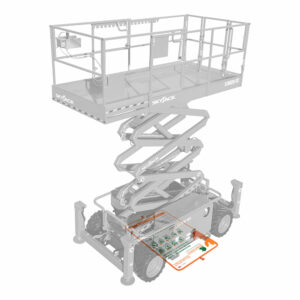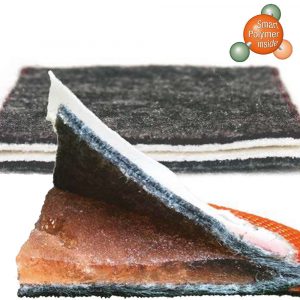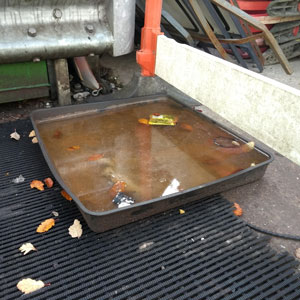
How EnviroPad Disrupts Spill Containment

The EnviroPad is a low maintenance spill pad that absorbs and neutralises hydrocarbons, and doesn’t leak in the rain. The largest variant absorbs over 44 litres of oil without sidewalls or a liner. By absorbing hydrocarbons and leaving water to run off, the EnviroPad can help to reduce your waste disposal costs. It is durable, safe to drive over, portable and can be used many times until capacity is reached. The Enviropad is available in a variety of sizes, making it a versatile compliance solution that can be used across construction, utilities, mining, workshop and plant hire industries. Let the EnviroPad help to manage your hydrocarbon spill risks and environmental compliance.
-
EnviroPad Spill Mat – M10 (Medium) 90 x 69cm
The EnviroPad is a revolutionary spill pad that captures and solidifies hydrocarbon spills including oils, fuels and hydraulic fluids. By using smart polymer technology, the EnviroPad turns these liquids into solid rubber, preventing any contaminants from leaking or leaching into the environment – even under pressure.
The EnviroPad is not affected by heavy rain or water, reducing contaminated waste disposal costs. It is safe to use outdoors in all weather conditions, and can be carried or stored upright after use. Its non-leaching characteristics mean that the EnviroPad can be safely disposed of landfill (subject to local and state regulations).
- Unique smart polymer spill pad
- Solidifies oil and fuel so it can’t leak out
- No pools of oily rainwater
- No risk of overflowing
- Doesn’t need sidewalls or a liner
- Can be safely used outdoors and jet washed
- Just as effective with Hydrotreated Vegetable Oil (HVO)
- Instructions printed on the top
- Absorbs up to 10.5L of oil
-
EnviroPad Spill Mat – L20 (Large) 137 x 91cm
The EnviroPad is a revolutionary spill pad that captures and solidifies hydrocarbon spills including oils, fuels and hydraulic fluids. By using smart polymer technology, the EnviroPad turns these liquids into solid rubber, preventing any contaminants from leaking or leaching into the environment – even under pressure.
The EnviroPad is not affected by heavy rain or water, reducing contaminated waste disposal costs. It is safe to use outdoors in all weather conditions, and can be carried or stored upright after use. Its non-leaching characteristics mean that the EnviroPad can be safely disposed of landfill (subject to local and state regulations).
- Unique smart polymer spill pad
- Solidifies oil and fuel so it can’t leak out
- No pools of oily rainwater
- No risk of overflowing
- Doesn’t need sidewalls or a liner
- Can be safely used outdoors and jet washed
- Just as effective with Hydrotreated Vegetable Oil (HVO)
- Instructions printed on the top
- Absorbs up to 20.2L of oil
-
EnviroPad Spill Mat – XL30 (X-Large) 137 x 137cm
The EnviroPad is a revolutionary spill pad that captures and solidifies hydrocarbon spills including oils, fuels and hydraulic fluids. By using smart polymer technology, the EnviroPad turns these liquids into solid rubber, preventing any contaminants from leaking or leaching into the environment – even under pressure.
The EnviroPad is not affected by heavy rain or water, reducing contaminated waste disposal costs. It is safe to use outdoors in all weather conditions, and can be carried or stored upright after use. Its non-leaching characteristics mean that the EnviroPad can be safely disposed of landfill (subject to local and state regulations).
- Unique smart polymer spill pad
- Solidifies oil and fuel so it can’t leak out
- No pools of oily rainwater
- No risk of overflowing
- Doesn’t need sidewalls or a liner
- Can be safely used outdoors and jet washed
- Just as effective with Hydrotreated Vegetable Oil (HVO)
- Instructions printed on the top
- Absorbs up to 30.4L of oil
-
EnviroPad Spill Mat – XXL40 (2X-Large) 218 x 137cm
The EnviroPad is a revolutionary spill pad that captures and solidifies hydrocarbon spills including oils, fuels and hydraulic fluids. By using smart polymer technology, the EnviroPad turns these liquids into solid rubber, preventing any contaminants from leaking or leaching into the environment – even under pressure.
The EnviroPad is not affected by heavy rain or water, reducing contaminated waste disposal costs. It is safe to use outdoors in all weather conditions, and can be carried or stored upright after use. Its non-leaching characteristics mean that the EnviroPad can be safely disposed of landfill (subject to local and state regulations).
- Unique smart polymer spill pad
- Solidifies oil and fuel so it can’t leak out
- No pools of oily rainwater
- No risk of overflowing
- Doesn’t need sidewalls or a liner
- Can be safely used outdoors and jet washed
- Just as effective with Hydrotreated Vegetable Oil (HVO)
- Instructions printed on the top
- Absorbs up to 44.3L of oil
How does the EnviroPad work?

The key to EnviroPad’s success is its innovative polymer technology, which absorbs hydrocarbon liquids such as petrol, diesel, hydraulic oil and solidifies it into a non-leaching form. After reacting, pollutants are unable to escape – even when the pad is compressed or pressurised. The EnviroPad is an alternative to traditional polypropylene absorbents, which act more like a sponge and can pose further environmental risks if they’re incorrectly handled or disposed of. EnviroPad smart polymer is:
- Non-toxic
- Non-carcinogenic
The EnviroPad can also be hung and stored after use without risk of leaching or dripping. Once absorbent capacity is reached, the EnviroPad swells to double its thickness and the edges will begin to discolour.
How EnviroPad helps leaking equipment

Working with fuels, hydraulic fluids and motor oil can get messy. Equipment such as diesel generators, excavators, trucks and machinery have seals that wear out over time, as oily drips and puddles begin to appear. When repairs aren’t economically viable, oil drip trays and portable bunds can mitigate oil leaks indoors. For equipment leaking outdoors, these containment types are less effective because they can also capture rainwater and other contaminants. If left unchecked, the risk of overflow and spillage becomes a real possibility, as does the risk of an environmental compliance penalty. Hazardous waste disposal costs are volume based, so you’ll pay more for rainwater contamination. The EnviroPad contains and absorbs oil and fuel leaks from equipment and helps to reduce waste disposal costs.
How EnviroPad helps onsite refuelling
Refuelling onsite can improve productivity, saving time and money. But whether you’re in the business of refuelling or outsourcing contractors to your site, petrol and diesel spills can happen between fills or when tanks overflow. On a heavily regulated building site, the last place you want hydrocarbons is on the ground or in stormwater runoff. Stormwater pollution is one of the most common environmental compliance offences, and is being actively targeted by local councils and the EPA. The EnviroPad helps to manage these risks, improving productivity and peace of mind on your worksite.
Where to use the EnviroPad

Potential uses for this spill pad are endless, though some of the most common tried and tested methods include:
- Generators, chainsaws and plant equipment – To capture leaks during storage.
- Refuelling stations – At the point of potential fuel spills.
- Heavy machinery, construction and mining workshops – Below leaking vehicles and equipment.
- Industrial transformers – During transport and storage.
The EnviroPad is ideal for absorbing hydrocarbon leaks and drips, as well as preventing stormwater runoff outdoors. Think of it as a low maintenance, set and forget compliance solution. EnviroPad can also be used to prevent slip hazards and protect flooring and concrete from stains. For emergency spills and fast flowing leaks, we recommend our range of spill kits and absorbents.
To enquire about the EnviroPad, view a sample or organise a demonstration, contact your Stratex representative or call 1300 991 180 and email [email protected].


































